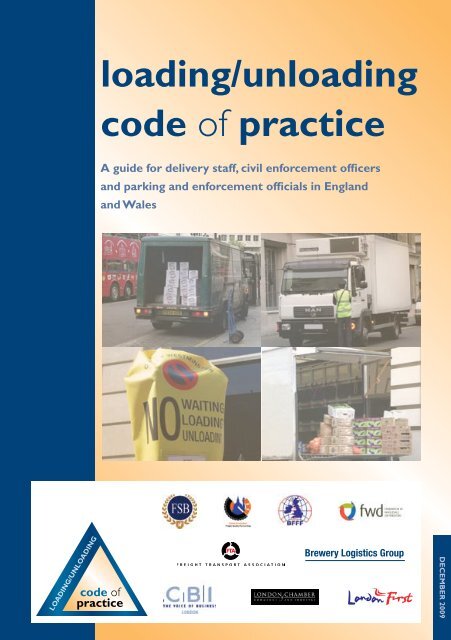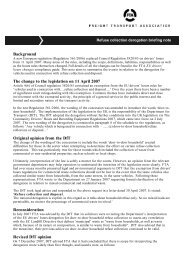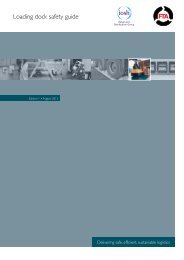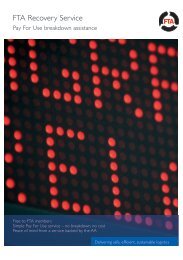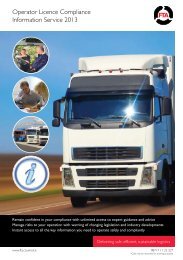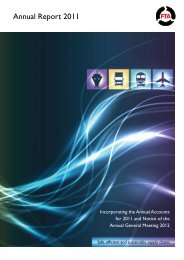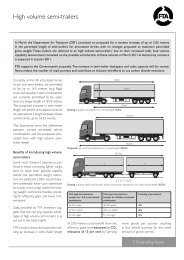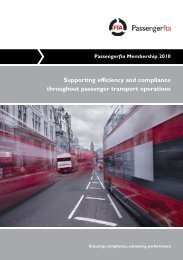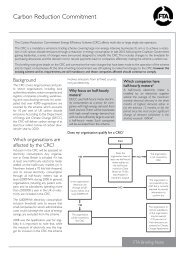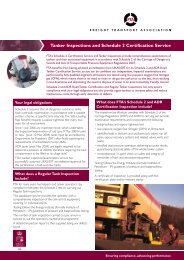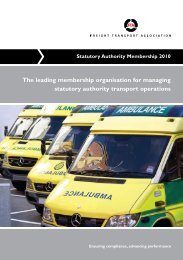loading/unloading code of practice - Freight Transport Association
loading/unloading code of practice - Freight Transport Association
loading/unloading code of practice - Freight Transport Association
- No tags were found...
You also want an ePaper? Increase the reach of your titles
YUMPU automatically turns print PDFs into web optimized ePapers that Google loves.
<strong>loading</strong>/un<strong>loading</strong><strong>code</strong> <strong>of</strong> <strong>practice</strong>A guide for delivery staff, civil enforcement <strong>of</strong>ficersand parking and enforcement <strong>of</strong>ficials in Englandand Wales<strong>code</strong> <strong>of</strong><strong>practice</strong><strong>loading</strong>/un<strong>loading</strong>December 2009
section 1 IntroductionAims and objectivesThe aim <strong>of</strong> this <strong>code</strong> <strong>of</strong> <strong>practice</strong> is to bring togetherstakeholders to work collectively to improve thecompetitiveness <strong>of</strong> UK business.The objective <strong>of</strong> this <strong>code</strong> <strong>of</strong> <strong>practice</strong> is to promotebest <strong>practice</strong> amongst business, traffic authoritiesand parking enforcement contractors to findpositive and effective solutions where <strong>loading</strong>/un<strong>loading</strong> is an ongoing problem.BackgroundDelivery and servicing is vital to the UK’seconomy. With limited road space and competingdemands, ensuring appropriate <strong>loading</strong>/un<strong>loading</strong>arrangements are available is very challenging.The situation can be exacerbated when there isincorrect enforcement, when drivers ignore therules and when communication between trafficauthorities and delivery companies is inconsistent.In order to address this increasingly criticalconcern the major business and industry groups/organisations that represent the interests <strong>of</strong>thousands <strong>of</strong> businesses which either receive ormake deliveries <strong>of</strong> goods and services in Londoncame together in early 2005 to try and address theproblems with deliveries, <strong>loading</strong>/un<strong>loading</strong> and topromote best <strong>practice</strong>.On jointly re-examining the issue it becameapparent that there were a whole range <strong>of</strong>concerns that needed to be resolved – strategic,administrative, organisational and system related.At the same time there were pockets <strong>of</strong> progressand various initiatives underway to improve thedelivery and servicing situation on the ground.The chosen way forward was to undertake a coordinatedpartnership approach, involving all thekey stakeholders – businesses, traffic authorities,London Councils and parking enforcementcontractors.In 2008, part 6 <strong>of</strong> the Traffic Management Act 2004was implemented. This somewhat harmonisedthe previously differing rules in London and therest <strong>of</strong> England and Wales. Since then, more andmore local authorities outside London have beengranted Civil Parking Enforcement powers. As such,this document is no longer London-specific but hastaken on a national focus.There has been a conscious effort to involverepresentatives <strong>of</strong> each <strong>of</strong> the stakeholders indeveloping this <strong>code</strong> <strong>of</strong> <strong>practice</strong>. The aim is toestablish this as an authoritative document that willbe useful for all those involved, resulting in a muchimproved situation on the ground.This shared document sets out commonly agreedprinciples to improve communication and makethe system work as best as it can. It is in everyone’sinterest to save time and resources by reducing thenumber <strong>of</strong> Penalty Charge Notices (PCNs) issuedthat relate to deliveries that are undertaken incompliance with regulations and are subsequentlyoverturned on appeal with the supply <strong>of</strong> suitableevidence.How to use this documentThis document should be incorporated into trainingprogrammes and used as a reference guide for allthose involved in delivery and servicing, parkingenforcement and traffic management, to ensurethe widest possible dissemination <strong>of</strong> best <strong>practice</strong>.How is enforcement carried out?Traffic authorities can enforce parking and certaintraffic regulations either by using civil enforcement<strong>of</strong>ficers who patrol the streets who can issue PCNsor via CCTV cameras (see section 5). There aretwo other circumstances where a PCN may beserved by post. Either where the civil enforcement<strong>of</strong>ficer has been prevented from serving the PCNby obstruction or threats <strong>of</strong> violence or where thePCN has started to be issued but the vehicle hasbeen driven <strong>of</strong>f before it has been placed on thewindscreen.What is <strong>loading</strong>/un<strong>loading</strong>?The rules for <strong>loading</strong> and un<strong>loading</strong> differ fromthose for other parking activities. Traffic orders thatrestrict or prohibit waiting in a street may exemptthe <strong>loading</strong> or un<strong>loading</strong> <strong>of</strong> goods. Some authoritiesdesignate kerbspace just for <strong>loading</strong>.Loading or un<strong>loading</strong> must be continuous whilethe vehicle is parked in restricted areas. It includestaking goods to where the recipient may reasonablyrequire them in the premises, waiting for them to bechecked, getting delivery or collection documentssigned and returning to the vehicle. Delivery staffare expected to secure their vehicle when they are
not with it and a vehicle can legitimately be lockedduring some <strong>of</strong> these stages. Once the deliveryprocess is complete, however, the driver mustmove the vehicle even if it is within the maximumperiod allowed for <strong>loading</strong> or un<strong>loading</strong>.Observation periodsThe purpose <strong>of</strong> an observation period is for a civilenforcement <strong>of</strong>ficer to observe any evidence <strong>of</strong><strong>loading</strong>/un<strong>loading</strong> activity at a vehicle in an areawhere parking is restricted, but <strong>loading</strong>/ un<strong>loading</strong>is allowed. The length <strong>of</strong> the observation period,depends on the traffic authority, the type <strong>of</strong>contravention and <strong>of</strong>ten on the vehicle type. Itshould be noted that observation periods arediscretionary on the part <strong>of</strong> the traffic authority,but authorities should publish their observationperiods and ensure their civil enforcement <strong>of</strong>ficersfollow them.Neighbouring authorities covering a continuousurban area should set the same observationperiods, as drivers may not know exactly whereone local authority area ends and another starts.There are two types <strong>of</strong> observation: casual andcontinuous. For casual observation, the standardprocedure is for the civil enforcement <strong>of</strong>ficer tonote vehicle details when they first see a possiblecontravention taking place and to return a shortwhile later or at intervals to see whether thereis any sign <strong>of</strong> <strong>loading</strong> or un<strong>loading</strong>. If not, the civilenforcement <strong>of</strong>ficer will issue a PCN.For continuous observation, the standardprocedure is for the civil enforcement <strong>of</strong>ficerto note the vehicle details when they first see apossible contravention taking place and stay nextto or near the vehicle, keeping it in sight at all times,for a set period (usually at least five minutes) to seeif there is any sign <strong>of</strong> <strong>loading</strong> or un<strong>loading</strong>. If not, thecivil enforcement <strong>of</strong>ficer will issue a PCN.An observation period is not a grace period. A graceperiod is a period <strong>of</strong> time where a contraventionis taking place but the authority chooses not toenforce.
section 2 Guidance for companies and delivery staffIntroductionIt is important to acknowledge that many urbanroads are overcrowded. Inevitably this means thatthe situation for delivery and servicing may not beperfect. Loading/un<strong>loading</strong> regulations should beobserved, but if you have particular deliveries thatyou are unable to make within the regulations, thendiscuss this with the relevant traffic authority to seeif a solution can be found.Principles1 Training to be given to all delivery staff aboutthe rules <strong>of</strong> <strong>loading</strong> and un<strong>loading</strong>• Every driver to be issued with a copy <strong>of</strong> this<strong>code</strong> <strong>of</strong> <strong>practice</strong>• Utilise training materials such as videos anddrivers’ cards• Drivers to have a driver’s card or similar inevery vehicle(A list <strong>of</strong> training materials is included insection 6.)2 Conform to parking regulations as far as isreasonably practicable• Ascertain delivery restrictions at customerpremises in advance <strong>of</strong> delivery wherepossible and plan route accordingly• If restrictions are in place, endeavour toadhere to restrictions or pursue alternatives(with the local authority and/or customers)• Ensure load planners are familiar with all parkingrestrictions• Always check signposts for parkingrestrictions• If a civil enforcement <strong>of</strong>ficer cannot be seenin the vicinity <strong>of</strong> the vehicle, do not assumethat parking regulations are not beingenforced. Traffic authorities are increasinglyutilising CCTV as a method <strong>of</strong> enforcement.See section 5, Closed Circuit Television(CCTV).3 Understand and respect the civil enforcement<strong>of</strong>ficer’s situation. They have an important rolein ensuring that rules are complied with andthat congested road space is used as effectivelyas possible• Always show respect to civil enforcement<strong>of</strong>ficers• Do not engage in confrontation• Accept PCNs, ascertaining that the detailsare correct. If not, do not take the issueup with the <strong>of</strong>ficer. Make a note <strong>of</strong> thediscrepancy and report back to yourtransport <strong>of</strong>fice on your return. If youdrive <strong>of</strong>f or the civil enforcement <strong>of</strong>ficerfeels threatened, the PCN can be sent bypost which will make the administration<strong>of</strong> payment or an appeal more difficult foryour company4 Always ensure that <strong>loading</strong>/un<strong>loading</strong> is takingplace. A definition <strong>of</strong> <strong>loading</strong>/un<strong>loading</strong> isprovided in section 1• Ensure that the delivery or pick up notice issigned, dated and timed by the customer• Personal and legally required breaks mustbe taken in accordance with parkingregulations and drivers’ hours rules5 Debrief delivery staff who receive a PCN whenthey return to depot• Discuss PCN report forms at daily debrief• Review and assess reasons for contraventionand record information6 Interview and re-train any driver whoconsistently receives valid PCNs• Ensure recorded information is used toaddress drivers who consistently receive adisproportionate number <strong>of</strong> valid PCNs• Ensure that there is an ongoing reviewprocess in place7 Discuss delivery issues with traffic authorities,customers and local residents to resolveproblems• Speak to customer to see if deliveryarrangements (location and/or time) can bealtered• If unable to resolve at customer level,engage in discussion with traffic authoritiesto find solutions, eg obtain a dispensation
section 3 Guidance for civil enforcement <strong>of</strong>ficersIntroductionDelivery staff have a difficult job to do. They are<strong>of</strong>ten under pressure to make deliveries in awkwardspaces within short timescales. Parking restrictionsalso vary between different traffic authorities.Delivery staff may therefore be genuinely unfamiliarwith the restrictions to which they are trying tocomply. Clear communication between deliverystaff and civil enforcement <strong>of</strong>ficers is therefore veryimportant to make a difficult situation as workableas possible.Principles1 Ensure you are familiar with local parking and<strong>loading</strong> restrictions• Take note <strong>of</strong> road signs and associatedlines2 Use procedures and training materials adoptedby your authority• Your local authority’s parking protocol• Civil enforcement <strong>of</strong>ficer’s handbook• This <strong>code</strong> <strong>of</strong> <strong>practice</strong>3 Understand and respect delivery staff’ssituation• Respect that drivers have a job to do• Do not engage in confrontation4 Where an infringement seems likely to occurtry to communicate this to the driver5 Record start and end times <strong>of</strong> all observationperiods6 Do not issue a PCN during the observationperiod if <strong>loading</strong>/un<strong>loading</strong> is clearly takingplace legitimately• Be familiar with your authority’s proceduresfor <strong>loading</strong>/un<strong>loading</strong> and how theobservation period is used• Remember that <strong>loading</strong>/un<strong>loading</strong> is notjust the physical element, but also involveschecking the goods and paperworkcompletion• Remember that the vehicle may be lockedup whilst the delivery is being completed7 Where possible clearly communicate to thedriver what the infringement is at point <strong>of</strong> PCNissue• Ensure PCNs are always placed on thefront <strong>of</strong> the vehicle, or handed to the driver,except in cases where this is not possiblebecause the vehicle was driven away beforeyou could finish issuing it• If the vehicle is about to be driven awaybefore you finish issuing a PCN, explainto the driver that it will be served by postinstead8 Ensure the PCN is always placed in a visibleposition on the front <strong>of</strong> the vehicle and take aphoto <strong>of</strong> the vehicle showing the PCN and thecontravention
section 4 Guidance for traffic authoritiesIntroductionParking restrictions vary between different trafficauthorities. This makes it difficult for deliverystaff who may be genuinely unfamiliar with therestrictions to which they should seek to comply.Communicating openly with delivery companies isa very helpful approach. It should help to reduce thenumber <strong>of</strong> times that restrictions are contravened,identify areas which cause particular problems andenable solutions to be jointly developed.Principles1 Standard training should be given to all civilenforcement <strong>of</strong>ficers about the needs <strong>of</strong>delivery vehicles• Use training materials• Every civil enforcement <strong>of</strong>ficer should beissued with a copy <strong>of</strong> this <strong>code</strong> <strong>of</strong> <strong>practice</strong>• Ensure <strong>of</strong>ficers are familiar with local trafficrestrictions and the signs and lines relatingto them• Give regular refresher training to civilenforcement <strong>of</strong>ficers2 Interview and re-train any civil enforcement<strong>of</strong>ficer who consistently issues large numbers<strong>of</strong> PCNs that are overturned on appeal• Ensure that information on overturnedPCNs is recorded and used to assess eachcivil enforcement <strong>of</strong>ficer’s performance3 Ensure civil enforcement <strong>of</strong>ficers’ incentives areonly linked to quality-related Key PerformanceIndicators (KPIs) and not to the number <strong>of</strong>PCNs issued4 PCNs issued where <strong>loading</strong>/un<strong>loading</strong> is notapparent should be cancelled at the earliestpossible opportunity where suitable evidenceis supplied5 Show transparency in measuring and reportingon PCN quality, cancellation rates, appealprocess results and make this information publicin annual parking reports in accordance withthe operational guidance provided for underPart 6 <strong>of</strong> the Traffic Management Act 20046 Use technology (such as hand-held computers)to limit opportunities for civil enforcement<strong>of</strong>ficers to make mistakes when issuing a PCN7 Publicise temporary changes in advance• Ensure changes in accordance with therequirements <strong>of</strong> statutory regulations arecommunicated via the authority’s website8 Supply and regularly maintain clear signage androad markings, with all positioning in accordancewith statutory requirements9 Work with deliverers, local businesses andresidents to identify and address problems with<strong>loading</strong>/un<strong>loading</strong> hotspots• Establish regular dialogue with deliverers(for example through <strong>Freight</strong> QualityPartnerships)• Regularly review the environment10 Work with other traffic authorities to developbest <strong>practice</strong>• Work towards a consistent approach toobservation periods• Work towards setting a standard approachto appeals processes, such as standardresponse times and customer servicestandards• Informal representations should beconsidered as it is in the interests <strong>of</strong> theauthority and the vehicle owner to resolveany dispute at the earliest possible stage.If a representation is received within thediscount period and subsequently rejected,the traffic authority should re-<strong>of</strong>fer thediscount for a further 14 days11 Work towards modifying s<strong>of</strong>tware andoperational <strong>practice</strong>s so that commercialvehicle PCNs can be identified. This will assistin identifying issues relating to deliveries t<strong>of</strong>acilitate management <strong>of</strong> hotspots12 If you use CCTV in PCN enforcement, furtherdetails are provided in section 5, Closed CircuitTelevision (CCTV)
section 5 Closed Circuit Television (CCTV)IntroductionTraffic authorities across the UK are increasinglyusing closed circuit television (CCTV) toenforce parking and traffic regulations. It maytake a variety <strong>of</strong> forms including fixed camerainstallations, mobile WiFi camera points andmobile vehicle units.It is important therefore that companies maketheir drivers aware that enforcement actionmay still be taking place by camera, even if thereare no civil enforcement <strong>of</strong>ficers visible on thestreet.Regulations under Part 6 <strong>of</strong> the TrafficManagement Act 2004 allow traffic authoritiesto use CCTV as a method <strong>of</strong> civil parkingenforcement. London Councils has issued a<strong>code</strong> <strong>of</strong> <strong>practice</strong> regarding the use <strong>of</strong> CCTV forparking and traffic enforcement and guidelinesare also issued by the Information Commissioneron the use <strong>of</strong> CCTV in general.Principles1 Camera operators should be trained in therelevant legislation. They should also undertakeCCTV training2 Camera operators should have maps toshow the relevant signs for the area they areenforcing, as the street signs are not alwaysfacing the camera3 Camera operators should enforce only whereroad, kerb and any other markings are clearlyvisible in the footage taken4 Camera operators should work in line with anenforcement protocol/<strong>code</strong> <strong>of</strong> <strong>practice</strong> thatsets out how parking and traffic regulations aremanaged5 Enforcing authorities must use CCTVenforcement in line with relevant legislation,including the Data Protection Act 1998 andTMA 20046 Camera operators should only focus closely onvehicles or individuals where there is a need todo so, ie to determine if <strong>loading</strong> and un<strong>loading</strong>is taking place before issuing a PCN7 Companies should ensure that their drivers arebriefed on CCTV enforcement as part <strong>of</strong> theirtraining in order to reduce the risk <strong>of</strong> receivinga PCN
section 6 Continuous improvementA partnership approach should lead to realimprovements in delivery and servicing andencourage a culture <strong>of</strong> rolling out best <strong>practice</strong> forall parties.To assist this:• new technology should be sought androlled out when systems are upgraded. Inparticular it is recommended that trafficauthorities move towards using digitalphotos and hand-held computers tosupport contraventionsIn order for this <strong>code</strong> <strong>of</strong> <strong>practice</strong> to help deliverreal improvements on the ground, as best <strong>practice</strong>develops, the document must be reviewed andupdated on a regular basis to ensure it is stillrelevant and helpful.A stakeholder group has been established tomonitor and review the <strong>code</strong> <strong>of</strong> <strong>practice</strong>.Useful documentsA number <strong>of</strong> valuable pieces <strong>of</strong> training and advisory material have been developed byindividual stakeholder groups recently and we encourage anyone who signs up to the<strong>code</strong> <strong>of</strong> <strong>practice</strong> to familiarise themselves with this information, and where requiredmake use <strong>of</strong> it with staff and management.PCN Management PackKeep it Moving DVDavailable for FTA membersavailable from Mike Bracey, Brewery Logistics Group(Includes driver’s card <strong>of</strong> parking regulations, (Best <strong>practice</strong> advice)PCN report form for driver de-brief, £35compliance guide) Tel: 01202 893613www.fta.co.uk/information/pcnsContactNatalie Chapman Secretary to the stakeholder grouptel: 01892 552346 email: nchapman@fta.co.ukInitiative and objectives supported by:To download this document go to www.fta.co.uk/assets/files/lu<strong>code</strong>.pdfThis revised document was published in December 2009 and replaces any earlier version


